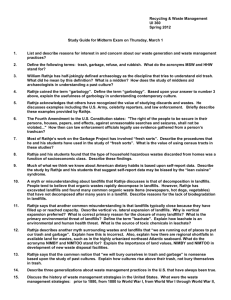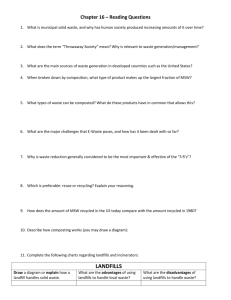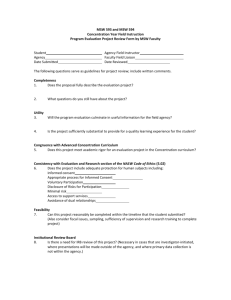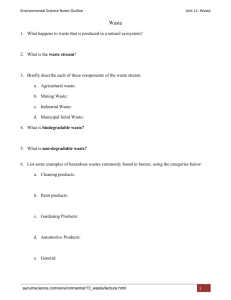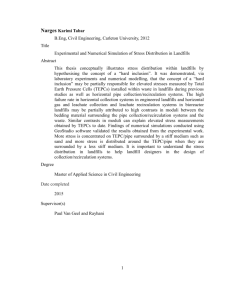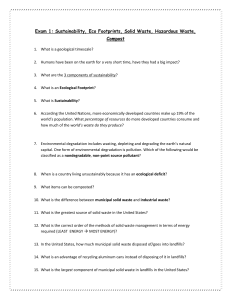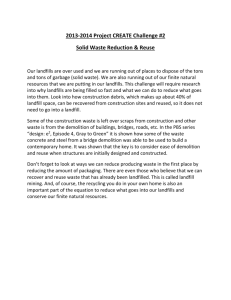Midterm Exam Study Guide
advertisement
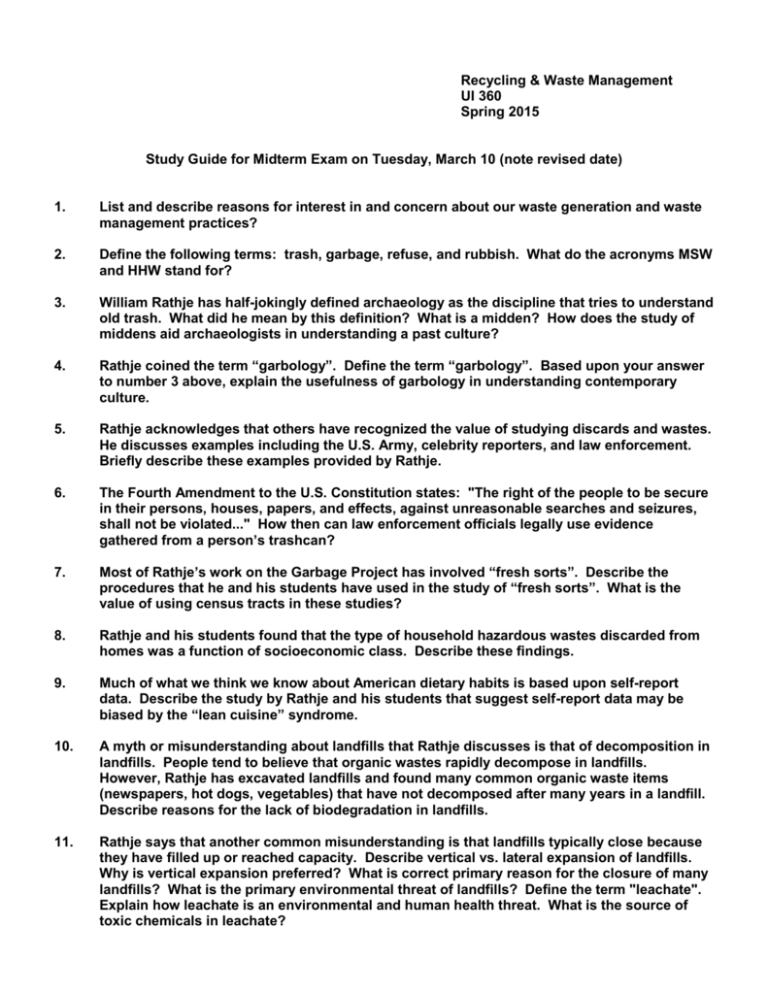
Recycling & Waste Management UI 360 Spring 2015 Study Guide for Midterm Exam on Tuesday, March 10 (note revised date) 1. List and describe reasons for interest in and concern about our waste generation and waste management practices? 2. Define the following terms: trash, garbage, refuse, and rubbish. What do the acronyms MSW and HHW stand for? 3. William Rathje has half-jokingly defined archaeology as the discipline that tries to understand old trash. What did he mean by this definition? What is a midden? How does the study of middens aid archaeologists in understanding a past culture? 4. Rathje coined the term “garbology”. Define the term “garbology”. Based upon your answer to number 3 above, explain the usefulness of garbology in understanding contemporary culture. 5. Rathje acknowledges that others have recognized the value of studying discards and wastes. He discusses examples including the U.S. Army, celebrity reporters, and law enforcement. Briefly describe these examples provided by Rathje. 6. The Fourth Amendment to the U.S. Constitution states: "The right of the people to be secure in their persons, houses, papers, and effects, against unreasonable searches and seizures, shall not be violated..." How then can law enforcement officials legally use evidence gathered from a person’s trashcan? 7. Most of Rathje’s work on the Garbage Project has involved “fresh sorts”. Describe the procedures that he and his students have used in the study of “fresh sorts”. What is the value of using census tracts in these studies? 8. Rathje and his students found that the type of household hazardous wastes discarded from homes was a function of socioeconomic class. Describe these findings. 9. Much of what we think we know about American dietary habits is based upon self-report data. Describe the study by Rathje and his students that suggest self-report data may be biased by the “lean cuisine” syndrome. 10. A myth or misunderstanding about landfills that Rathje discusses is that of decomposition in landfills. People tend to believe that organic wastes rapidly decompose in landfills. However, Rathje has excavated landfills and found many common organic waste items (newspapers, hot dogs, vegetables) that have not decomposed after many years in a landfill. Describe reasons for the lack of biodegradation in landfills. 11. Rathje says that another common misunderstanding is that landfills typically close because they have filled up or reached capacity. Describe vertical vs. lateral expansion of landfills. Why is vertical expansion preferred? What is correct primary reason for the closure of many landfills? What is the primary environmental threat of landfills? Define the term "leachate". Explain how leachate is an environmental and human health threat. What is the source of toxic chemicals in leachate? 12. Rathje describes another myth surrounding wastes and landfills that “we are running out of places to put our trash and garbage”. Explain how this is incorrect. Also, explain how there are regional shortfalls in available land for wastes, such as in the highly urbanized northeast Atlantic seaboard. What do the acronyms NIMBY and NIMTOO stand for? Explain the importance of land values, NIMBY and NIMTOO in development of new waste disposal facilities. 13. Rathje says that the common notion that “we will bury ourselves in trash and garbage” is nonsense based upon the study of past cultures. Explain how cultures rise above their trash, not bury themselves in trash. 14. Describe three generalizations about waste management practices in the U.S. that have always been true. 15. Discuss the history of waste management strategies in the United States. What were the waste management strategies: prior to 1880, from 1880 to World War I, from World War I through World War II, and from World War II to the present? Discuss reasons for the changes in waste management strategies during these periods. Discuss the impacts of the following societal events on American waste management: World War I, the Great Depression, World War II, Love Canal, and the OPEC oil embargo. 16. Discuss major sociological and technological changes of the 1950’s and 1960’s that encouraged development of a “throw-away” society in the United States. 17. Provide a brief history of Love Canal. Why are the events of the early 1970s at Love Canal often called “the awakening of America to the problem of toxic chemical wastes”? Why did the events at Love Canal enrage and frighten the American public? 18. Name the two landmark federal laws enacted by Congress in response to public concern over toxic chemicals. Give the meaning of the following acronyms: RCRA, CERCLA, SARA, PRP, and NPL. 19. What was the purpose or intent of the Resource Conservation and Recovery Act (RCRA), Subtitle C? 20. Explain the “cradle-to-grave” provision of RCRA for management of hazardous, toxic chemicals. What are "de minimis" generators with regard to RCRA regulations? 21. RCRA allows states to establish their own regulations on hazardous chemicals. Describe the relationship between federal and state statutes regarding hazardous chemical regulations. Describe how the development of varying state statutes has resulted in a patchwork quilt of regulations for management of hazardous chemicals. 22. What was the purpose or intent of the Comprehensive Environmental Response, Compensation, and Liability Act (CERCLA)? 23. What is the common name for CERCLA? How effective was CERCLA during the 1980s? Where did much of the money for CERCLA go during the 1980s? How has the Superfund Amendment and Reauthorization Act (SARA) been more effective than CERCLA? 24. How are sites evaluated for placement on the NPL? 25. Explain the “polluter pays” provision of CERCLA/SARA? What problems may be encountered in making the PRP pay? If the PRP cannot be made to pay, then what are the sources of funds for cleanup? Does CERCLA/SARA provide protection and compensation to individuals for damages resulting from toxic waste sites? 26. What factors encouraged a “rush to burn” outlook on MSW in the 1970s? What is the meaning of the acronym PURPA? How did PURPA encourage the “rush to burn” perspective? Where in the United States are most MSW incinerators located? 27. It was predicted in the 1970s that incineration would become the primary method for management of MSW in the United States by the year 2000. Why has the prediction of the 1970s not come true? 28. What is the source of toxic chemicals in MSW? What happens to toxic inorganic chemicals (such as heavy metals) during the combustion process? What happens to highly flammable, toxic organic chemicals such as paint thinner during incineration? What are the toxic combustion byproducts of some chlorinated wastes such as PVC plastics and PCBs? 29. Describe the protracted legal battle over MSW incinerator ash. What was the basis of concern about the ash? Describe the viewpoint that MSW incinerator ash should be considered Subtitle D material under RCRA regulations. Describe the viewpoint that MSW incinerator ash should be considered Subtitle C material under RCRA regulations. What was the ruling of the U.S. Supreme Court on this case? 30. What is the Toxicity Characteristic Leaching Procedure (TCLP)? How must ash be handled and disposed of if the TLCP test shows MSW incinerator ash to be high in toxic chemicals? 31. Both the plastics industry and the waste-to-energy industry would like to count incineration of plastics as a form of recycling? Explain why both industries favor incineration of plastics and why they would like the public to accept the idea of incineration as a justifiable form of recycling plastics. 32. Explain how MSW incineration can compete with source reduction and recycling as methods for management of MSW. 33. During the 1980s the federal government failed to provide leadership on solid waste management. The California Integrated Waste Management Board (CIWMB) assumed a much needed leadership position. What are the 3 Rs of solid waste management? Describe the integrated waste management hierarchy proposed by the CIWMB. What is the new name given to the CIWMB? 34. Discuss the provisions of Subtitle D of RCRA regarding municipal solid waste landfills. You should include consideration of location restrictions, financial assurance requirements, requirement for owner/operator to demonstrate compliance, the ability of citizens to bring lawsuits, record keeping requirements, and remediation requirements. 35. Discuss the provisions of Subtitle D of RCRA regarding design criteria for MSW landfills including the structure and function of the bottom liner, leachate collection system, leachate treatment, methane management, monitoring wells, and cover liner.
